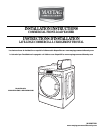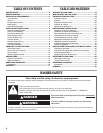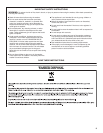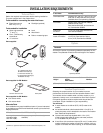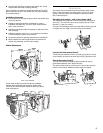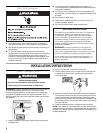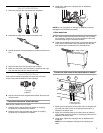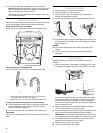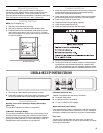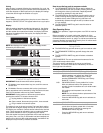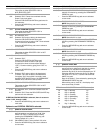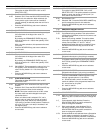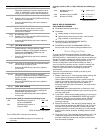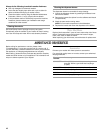
8
4. Turn on the water taps completely and check for leaks.
NOTE: Replace inlet hoses after 5 years of use to reduce the
risk of hose failure. Record hose installation or replacement
dates on the hoses for future reference.
Periodically inspect and replace hos
es if bulges, kinks, cuts,
wear, or leaks are found.
Route the Drain Hose
Proper routing of the drain hose protects your floor from damage
due to water leakage. Read and follow these instructions.
Remove drain hose from the washer
Gently pull the corrugated drain hose from the shipping clips.
Laundry tub drain or standpipe drain
Connect the drain hose form to the
corrugated drain hose.
A B
A.Snap either end of the drain hose form to the drain hose
at the point where the corrugation begins.
B.Bend drain hose over drain hos
e form and snap into place.
To keep drain water from going back into the washer:
■ Do not straighten the drain hose, do not force excess drain
hose into standpipe. Hose should be secure, but loose
enough to provide a gap for air.
■ Do not lay excess hose on the bottom of the laundry tub.
Floor drain
You may need additional parts. See Floor drain under “Tools and
Parts.”
Secure the Drain Hose
1. Drape the power cord over the washer top.
2. Move the washer to its final location.
3. Plac
e the drain hose in the laundry tub or standpipe as
shown. See illustrations A and B.
4. Secur
e the drain hose using the supplied beaded tie strap.
A BC
5. If the washer taps and the drain standpipe are recessed, put
the hooked end of the drain hose in the standpipe as shown.
See illustration C.
NOTES:
■ Do not force excess drain hose back into the rear of the
washer.
■ To avoid siphoning, do not seal the drain hose into the
standpipe.
Level the Washer
Properly leveling your washer avoids excessive noise and
vibration.
1. Check the levelness of the washer by placing a level on the
top edge of the washer, first side to side, then front to back.
If the washer is against a wall, move the washer out slightly
before tipping back. If the washer is not level, first prop the
front with a wood block and adjust the feet as necessary;
then prop the back and adjust feet as necessary. Repeat this
step until washer is level.
2. Ma
ke sure all four feet are stable and resting on the floor.
Check that the washer is level (use a level).
3. Aft
er the washer is level, use a 9/16" open-end wrench to turn
the nuts on the feet tightly against the washer cabinet.
IMPORTANT: All four fe
et must be tightened. If the nuts are
not tight against the washer cabinet, the washer may vibrate.
4. The
washer should not move front to back, side to side, or
diagonally when pushed on its top edges.
5. Slid
e the washer to its final location.
6. Conf
irm the levelness of the washer.



